|
 Nederlands /
Dutch Nederlands /
Dutch
Butterflies and moths in the garden
Subpage butterflies and moths: Butterflies
Owlet
moths, noctuidae Geometer
moths Leafrollers,
tortrix moths Pyralidae,
Crambidae Concealer
moths, Oecophoridae
In Dutch we have "vlinders" (butterflies), "nachtvlinders"
(nightbutterflies) and motten (small moths). I like the name
nightbutterflies.
Butterflies and moths belong to the same order Lepidoptera. They are both called
lepidopterans.
The butterflies always fly during the day and they are often beautiful
coloured. In moths, there are also many species
which fly during the day (day active moth) and
sometimes also are beautiful coloured.
A characteristic of moths are the long feelers,
or antennae.
They don't have clubbed
antennae
like the butterflies.
They are often comb-like or feathery, or filamentous.
Most
moths have no bright colours (brown, grey, white or black) and often with
patterns of which help camouflage them during the day.
Moths
tend to have stout and hairy bodies to conserve heat during the cooler nights.
There’s a coupling of the forewing with the hindwing. Unlike
moths, butterflies generally hold their wings together above their backs when
resting.
|
Butterflies.
The butterflies (family skippers or skipper butterflies (Hesperiidae), family
Blues (Lycaenidae), family Nymphalidae, family Pieridae) are now on a subpage.
Subpage butterflies.
|
Moths.
I have made subpages of some families. On this page I have placed a photo of
one species of the family and a link.

Uncertain(Hoplodrina
octogenaria, synonym Hoplodrina alsines)
Family Noctuidae or Owlet moths. |
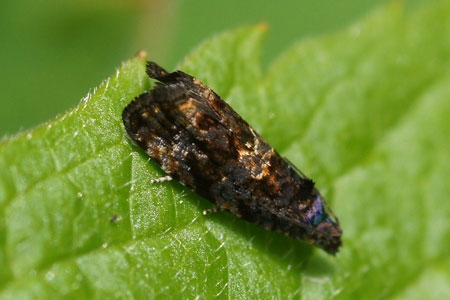
Endothenia ustulana. Family
Tortricidae or tortrix moths (leafrollers).
|
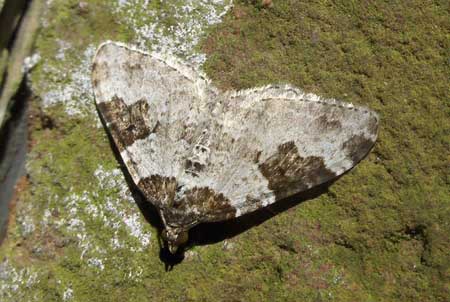
Garden Carpet
(Xanthorhoe fluctuata). Family
geometer moths
(Geometridae).
|
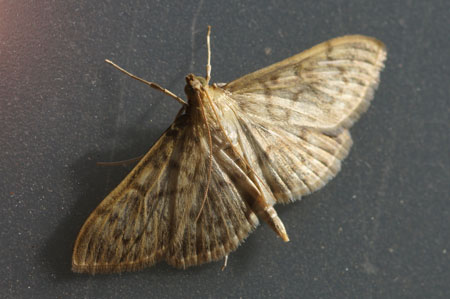
Mother of Pearl (Pleuroptya ruralis). Family grass moths (Crambidae). |
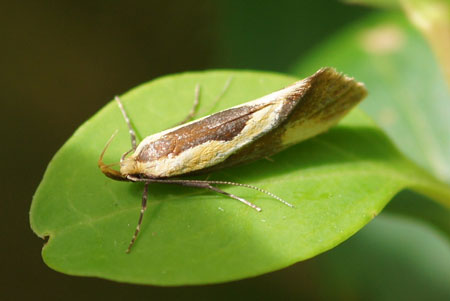
Harpella forficella. Family Concealer moths
(Oecophoridae). |
|
Adelidae.
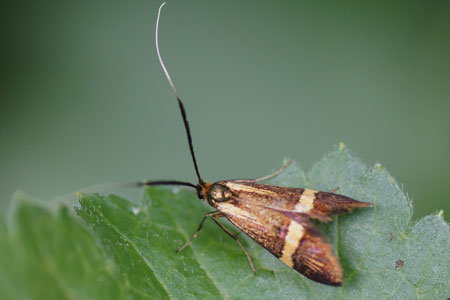 Female.
Female.  Male. Longhorn Moth, Yellow-barred long-horn (Nemophora degeerella). Family Adelidae.
Male. Longhorn Moth, Yellow-barred long-horn (Nemophora degeerella). Family Adelidae.
It is a female. The male's antennae are much longer. They are around 30 mms long. It also is a day-active moth.
You can find the butterfly on bistort, nettle and daisy.
The caterpillar feeds on leaf remains of birches. Flying time April to June. Photos 5-6-2012, 6-6-2012. German: Langhornmotte. French: Coquille d'or. |
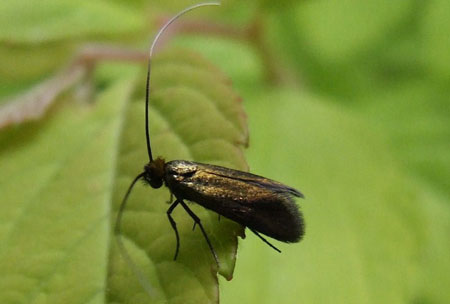 .. ..
 . .
 Cauchas rufimitrella. Family Adelidae.
Cauchas rufimitrella. Family Adelidae.
This moth has a beautiful metallic glow.
It is a day-active moth.
Wingspan 10-12 mm.
Caterpillars live on the seeds of Cardamine pratensis. An other foodplant
is garlic mustard. (last photo)
Flying time May to June.
Last photo 19-5-2010. |
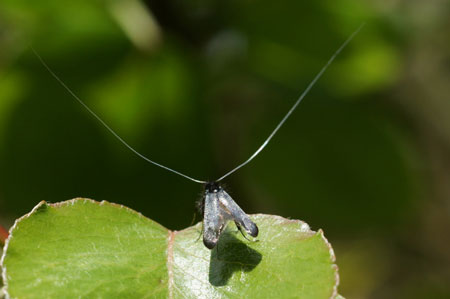 .. ..
 Male Male
 Female. Green longhorn (Adela reaumurella). Family
Adelidae.
Female. Green longhorn (Adela reaumurella). Family
Adelidae.
A
day-active metallic green moth. The caterpillars live on leaf remains.
Wingspan 14-18 mm.
Female green longhorn has shorter antennae:
Flying time May to June.
The males are often dancing near the bushes. Photos 5 -5 2010. 14-5-2011. |
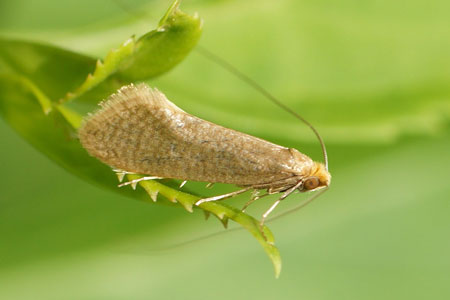 .. ..
 . .
 . .
 Nematopogon adansoniella. Family Adelidae.
Nematopogon adansoniella. Family Adelidae.
It is a day-active moth. It looks like the Nemapogon swammerdamella. But Nemapogon adansoniella has
grey brown / white ringed
antennae. See detail photo. Forewings are ochreous with a grid
Wingspan 17-19 mm.
Hosts: Common Beech, oak, Prunus spinosa (blackthorn or sloe) and Bilberry
April-June. One generation. Europe. Photos 24-4-2010,
4-5-2014. |
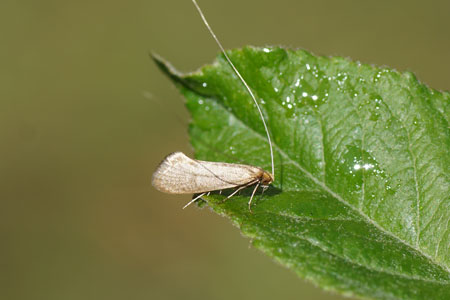 Nematopogon swammerdamella. Family Adelidae.
Nematopogon swammerdamella. Family Adelidae.
Nemapogon swammerdamella has pale wings with little pattern. Pale antennae. Wingspan 18-21 mm.
Host plants: Various herbaceous plants.
April-June. One generation. Europe. Photo 27-4-2025. |
Many-plumed moths
(Alucitidae).
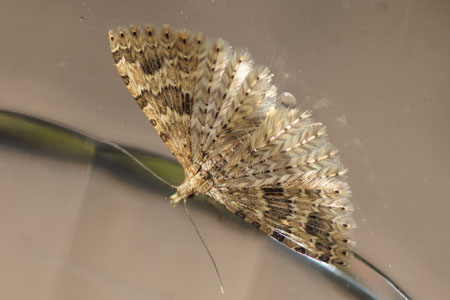 .. ..
 . .
 Twenty-plume Moth (Alucita hexadactyla). Family Many-plumed moths (Alucitidae). The wing is divided into 6 plumes.
Twenty-plume Moth (Alucita hexadactyla). Family Many-plumed moths (Alucitidae). The wing is divided into 6 plumes.
A common moth. I don't see it in the garden, but sometimes (like this moth) I find it in our house. In the Netherlands there is only one other member of the family, namely the rare Alucita Grammodactyla.
Wingspan: about 14-16 mm.
Host: Honeysuckle. The caterpillars feed on the buds and leaves. Sometimes they mine the leaves.
Throughout the year. The moth overwinters.
Europe, introduced in America. Photos 16-10-2012. German:
Geißblattgeistchen. |
Chimabachidae.
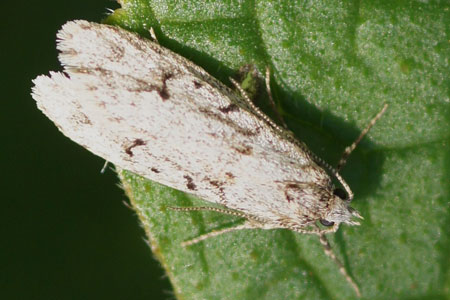 .. ..  . .  . .
 Diurnea fagella. Family Chimabachidae.
Diurnea fagella. Family Chimabachidae.
The females have short wings and can't fly. Males can be both light and dark.
Host plants are deciduous trees like beech, oak and birch. The eggs are deposited on the bark.
It hibernates as a pupa. March-May. One generation.
Wingspan 19-29 mm. Europe. Photos 8-4-2011, 29-3-2014. German:
Buchenmotte. |
Metalmark moths, Choreutidae.
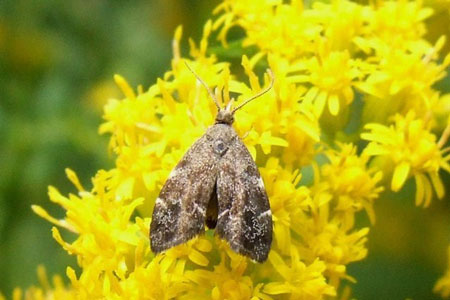 .. ..
 . .
 Anthophila fabriciana. Family Metalmark moths (Choreutidae).
Anthophila fabriciana. Family Metalmark moths (Choreutidae).
A very small butterfly. Wingspan: 10-15 millimeters.
It flies in May to October. Two generations. It is most seen in June and September.
Widespread in the Palearctic ecozone.
The caterpillar feed on nettles. |
 Apple Leaf Skeletonizer (Choreutis pariana). Family Metalmark moths (Choreutidae).
Apple Leaf Skeletonizer (Choreutis pariana). Family Metalmark moths (Choreutidae).
The wings are reddish brown to gray with a dark zigzag line with a light band. The head is grey brown.
Host plant for the caterpillar: Mainly apple (Malus) It eats the chlorophyll from the upper surface of the leaf, thus you get the skeleton of the leaf.
It is not a very common moth in the Netherlands and it flies mainly in gardens with apple trees.
Wingspan 11-15 mm.
Especially in July and September. Two generations. Native to Europe, Asia. Introduced in North America. Photo 23-7-2012. |
Case-bearers, casebearing moths or case moths
(Coleophoridae).
Small, slender moths. The larvae are first ordinary leafminers, but later they live in a
case made of silk that is hardened by secretion and usually also from plant material.
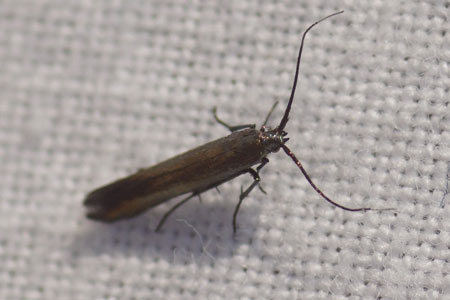 .. ..
 Clover case-bearer, small clover case-bearer (Coleophora alcyonipennella). Family case-bearers
(Coleophoridae).
Clover case-bearer, small clover case-bearer (Coleophora alcyonipennella). Family case-bearers
(Coleophoridae).
The moth is black with an orange metallic irisation. It is similar to the Coleophora deauratella (11-13 mm) and Coleophora trifolii (15-20 mm). The sizes differ slightly and it differs also by the white ends of the antenna.
Wingspan: 12-14 mm.
Host plants: Clover (Trifolium) and Knotweed (Centaurea). Especially white clover (Trifolium repens). The caterpillar eats the ripening seeds, living in a tube of dried petals.
May - June and July-August, Two generations. The caterpillar hibernates during a diapause.
Europe, Pakistan, the Near East and North Africa. Introduced in New Zealand and Australia. Photos 4-8-2018.
 White ends of the antenna.
White ends of the antenna. |
Hook-tips
(Drepanidae).
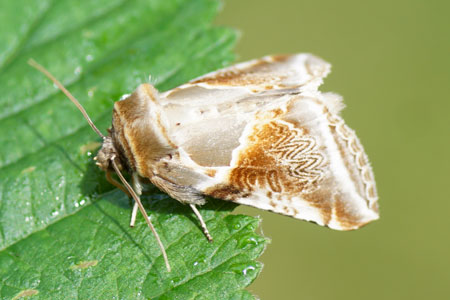 Buff Arches (Habrosyne pyritoides). Family hook-tips (Drepanidae).
Buff Arches (Habrosyne pyritoides). Family hook-tips (Drepanidae).
The forewings are smooth grey, white with a reddish brown part with a drawing of white, orange-brown zigzag pattern. The hindwings are grey with white edges. A very special moth, which, although it is common, I saw for the first time in 2025 in our garden. Wingspan: 40-45 mm. Host plants: Blackberry, raspberry. One generation. The pupa overwinters in the litter layer. Europe, Asia Photo
24-6-2025. German: Achat-Eulenspinner. French:
Ratissée. |
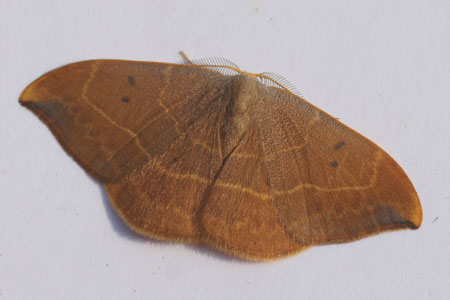 .. ..
 Oak Hook-tip (Watsonalla binaria formely Drepana binaria). Family hook-tips
(Drepanidae).
Oak Hook-tip (Watsonalla binaria formely Drepana binaria). Family hook-tips
(Drepanidae).
Brown forewings with two dark discal spots and two pale transverse lines. As with many hook-tips it has a distinctively hook-shaped apex to the forewing. The Barred Hook-tip (Watsonalla cultraria) looks like this moth, but is browner and has one discal spot.
Wingspan: 18-35 mm.
Host plants: Especially oak.
April-September. Two generations. The pupa overwinters in a folded oak leaf.
Europe, North Africa. Photos 23-8-2013. German: Eichen-Sichelflügler, Zweipunkt-Sichelflügler. French: Hameçon. |
Twirler moths or gelechiid moths
(Gelechiidae).
The moths have curved palps.
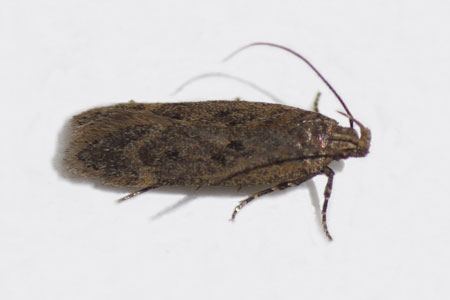 Bryotropha.
Family Twirler moths or gelechiid moths (Gelechiidae). Bryotropha.
Family Twirler moths or gelechiid moths (Gelechiidae).
Similar species include Bryotropha desertella, Bryotropha terrella, and Bryotropha senectella. Their forewings are brown with dark spots.
The caterpillars of Bryotropha species feed on mosses. Photo: July 15, 2025. |
Gracillariidae.
From Wikipedia: The first to fifth-instar larvae of the Gracillariidae are usually very flattened and have
possess specialised mouthparts adapted for feeding on sap. The major part of the caterpillars live as a leaf miner in leaves.
Older-instar larvae are cylindrical and have normal chewing mouthparts for feeding on plant tissue within the leaf mines, and have a fully functional silk-producing organ, the "spinneret".
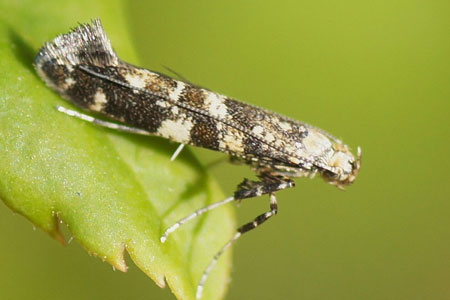 .. ..
 . .
 . .
 Lilac Leafminer, Privet Leafminer (Gracillaria syringella). Subfamily Gracillariinae. Family
Gracillariidae.
Lilac Leafminer, Privet Leafminer (Gracillaria syringella). Subfamily Gracillariinae. Family
Gracillariidae.
Forewings are brown with light stripes and spots. Variable. (compare it to the last two pictures below) Hindwings brownish gray.
May-August. Two generations. The pupae overwinter.
Wingspan: 10-13 mm.
Host plants for the caterpillars are different species of lilac (Syringa), privet (Ligustrum) and Ash (Fraxinus). Eggs are laid on the underside of leaves along the veins. Photos 5-5-2013. German: Fliedermotte.
 Male, female. 2-5-2014.
Male, female. 2-5-2014. |
 .. ..
 Horse-chestnut leaf miner (Cameraria ohridella). Subfamily Gracillariinae. Family Gracillariidae.
Horse-chestnut leaf miner (Cameraria ohridella). Subfamily Gracillariinae. Family Gracillariidae.
Formerly all the leaves of our horse chestnuts were beautiful green in summer. Now they begin to brown in June already. That's because of the larvae of the chestnut leaf miner. The larvae eat through the veins of the leaves and making large parts brown. (see photo below). The chestnut leaf miner isn't native in the Netherlands. In 1985 it was found for the first time in Europe. (1999, Netherlands) It is probably from Asia. Amazing that all trees are brown by the larva of such a small insect. The moth is 5 mm long. It has a few natural enemies like the great tits and some parasitic wasps.
The forewings are shiny light brown with white bands. The hindwings are dark gray.
May-September. Several generations. Wingspan: 8 mm.Photos 18-5-2013.German:
Rosskastanienminiermotte, Balkan-Miniermotte.
 Leaf of a Chestnut, 26-6-2012.
Leaf of a Chestnut, 26-6-2012. |
Swift moths or ghost moths (Hepialidae)
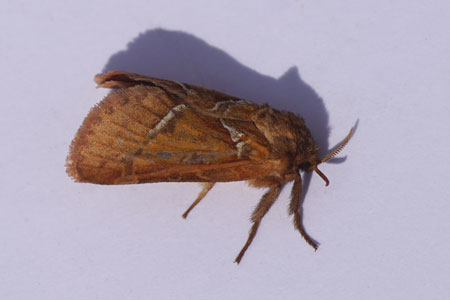 .. ..
 Orange swift or orange moth (Triodia sylvina). Familie swift moths or ghost
moths (Hepialidae).
Orange swift or orange moth (Triodia sylvina). Familie swift moths or ghost
moths (Hepialidae).
Male is orange-brown with two diagonal white stripes. Female is grey-brown. Caterpillar: September-June and overwinters twice on the roots, which it also eats. Host plants include dandelion, bracken and sorrel. Flight perod July-September. One generation.
Wingspan 30 -50 mm (females are larger than males). Europe. Photos 13-8-2020. |
Incurvariidae.
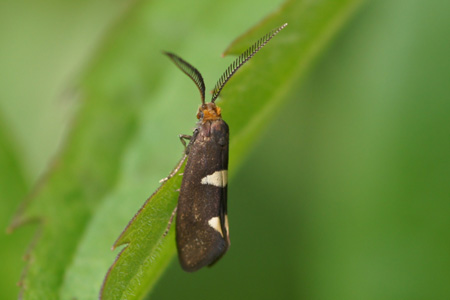 Incurvaria masculella. Family Incurvariidae.
Incurvaria masculella. Family Incurvariidae.
Features: Brown wings with white spots. The males have combed antennas.
The young larva is a leaf miner (May, June). After the first moult, they make an excision out of the mine and live on the soil feeding on dry leaves.
 Caterpillar. Photo 10-7-2012.
Caterpillar. Photo 10-7-2012.
The hostplants are hawthorn (especially in Great-Britain) oak, birch, rose, common bilberry.The caterpillar hibernates.
April-June Wingspan 12-16 mm. Europe. |
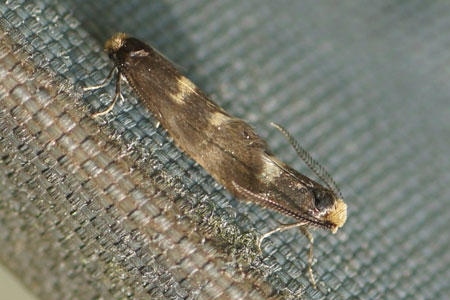 Incurvaria pectinea. Family Incurvariidae.
Incurvaria pectinea. Family Incurvariidae.
It looks like the Incurvaria pectinea. The spots of the Incurvaria pectinea are not as sharply defined. The wings are brown but paler.
The young larva is a leaf miner like the lava of the Incurvaria masculella
Host plants: Deciduous trees like birch, apple, hazel, hornbeam.
April-May. Wingspan 12-16 mm. Europe. Photo 8-5-2013. |
Limacodidae.
 .. ..
 Festoon (Apoda limacodes). Family Limacodidae.
Festoon (Apoda limacodes). Family Limacodidae.
The forewings are broad and short. They are light brown (female paler) with two dark lines running from each other, which sometimes form the border of a dark area. (not the festoon on the picture).
Wingspan: 20-30 mm.
Host plants for the caterpillars are deciduous trees, especially oak and beech. The caterpillar has no visibility legs and moves like a snail.
May-August. One generation. The caterpillars overwinter in a cocoon under the fallen leaves.Photos 2-8-2013. German: Großer
Schneckenspinner. French: La Tortue. |
Tussock moths
(Lymantriidae).
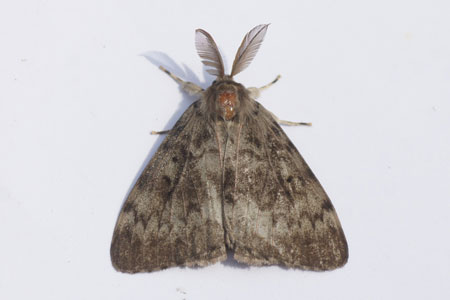 .. ..
 Gypsy Moth (Lymantria dispar). Family Tussock moths
(Lymantriidae).
Gypsy Moth (Lymantria dispar). Family Tussock moths
(Lymantriidae).
This is a male. The larger females are white or yellowish white with dark zigzag lines and don't fly much (or don't fly). The male is distinguished by the strong feathery antennae. Its forewings are dark brown with some wavy dark lines.
Wingspan: 32-55 mm.
Host Plants: Many different kinds of deciduous trees and shrubs.
June-August. One generation. The eggs overwinter. They are deposited in bark crevices. The caterpillars spread in the spring by silk threads in the wind. They can grow to 7 cm long.
Palearctic, as exotic species throughout the Nearctic region.Photos 24-8-2013. German:
Schwammspinner. French: Bombyx disparat.
 Caterpillar of a gypsy moth (Lymantria dispar). Photo 20-5-2009.
Caterpillar of a gypsy moth (Lymantria dispar). Photo 20-5-2009. |
Tuft moths
(Nolidae).
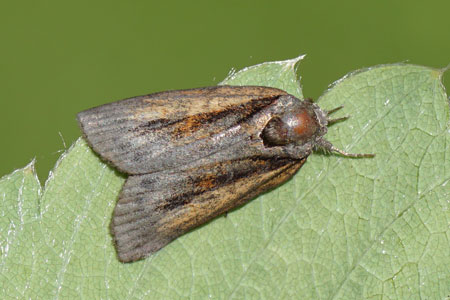 Oak nycteoline (Nycteola revayana). Family tuft moths
(Nolidae).
Oak nycteoline (Nycteola revayana). Family tuft moths
(Nolidae).
A very variable species. Wingspan 20-25 mm.
Host plants for the caterpillar are oaks. Almost all year. Two generations, in spring and autumn. Second generation overwinters. Europe, North Africa to the Middle East and India.
Photo 23-7-2024. German: Eichenhain-Wicklereulchen. French:
Sarrothripe de Revay. |
Tandvlinders
(Notodontidae).
Prominent Moths
(Notodontidae).
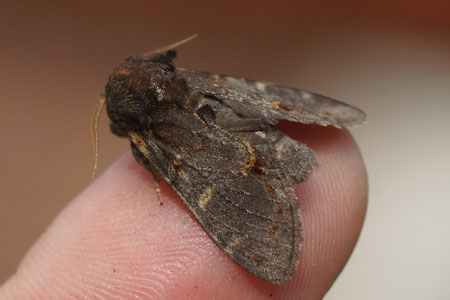 .. ..
 . .
 Iron Prominent (Notodonta dromedarius).
Family Prominent Moths
(Notodontidae).
Iron Prominent (Notodonta dromedarius).
Family Prominent Moths
(Notodontidae).
Dark gray-brown with a few pale brown elongated spots.
Host plants for the caterpillars are birch, alder, oak and hazel,
May-August One generation. The dromedary overwinters as a pupa.
Europe, Asia Minor. Photos 24-8-2013. German: Dromedar-Zahnspinner, Erlen-Zahnspinner. French: Le Chameau. |
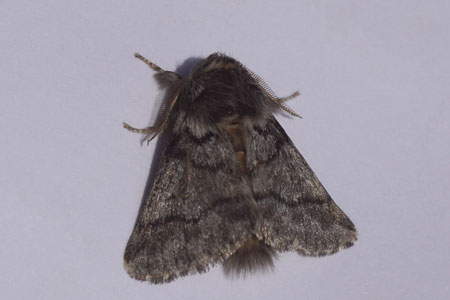 .. ..
 Oak processionary (Thaumetopoea processionea).
Family Prominent Moths (Notodontidae).
Oak processionary (Thaumetopoea processionea).
Family Prominent Moths (Notodontidae).
A southern species. Before 1980 the oak processionary was found in the
Netherlands rarely in Limburg and Brabant. They are constantly expanding
now. This is the first moth that I see here. No caterpillars yet. The caterpillars go in rows at night in search of food. It can be very many.
They try to controle them, for their defensive bristles cause a lot of skin irritations,.
The forewings are brownish, yellow-gray with blackish cross lines. Span width 25-32 mm.
Host plants for the caterpillar are oaks. July-early September. One generation. Caterpillar May - June.
The eggs overwinter. Europe, Asia. Photos 6-8-2019. German:
Eichen-Prozessionsspinner. French: la Processionnaire du chêne. |
Plutellidae.
 .. ..
 Dame's Rocket Moth, Plutella porrectella. Family Plutellidae.
Dame's Rocket Moth, Plutella porrectella. Family Plutellidae.
A light gray moth with in the longitudinal direction a brown line. The antennae have near the tip three dark rings.
Wingspan: 14-17 mm.
The moth flies easily away when you walk through the garden.
Host plants for the caterpillar: Dame's violet (Hesperis matronalis).
April to November. Two generations. The caterpillars distort or connect the leaves with silk. The eggs overwinter. The caterpillars pupate in a cocoon at the underside of a leaf.
Europe, Asia Minor, North America. Photos 14-8-2012. |
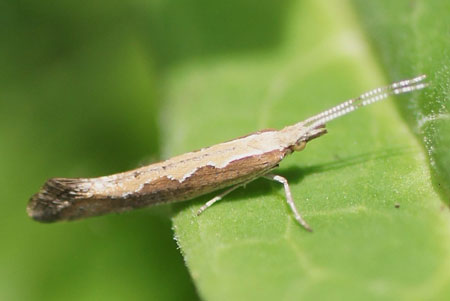 Diamondback moth, cabbage moth (Plutella xylostella). Family
Plutellidae.
Diamondback moth, cabbage moth (Plutella xylostella). Family
Plutellidae.
The forewings are divided into a pale part and a dark part with an waving dividing line.
Wingspan: 13-15 mm.
Host plants for the caterpillar: Plants from the cabbage family and Tropaeolaceae. The caterpillars in the first days leafminers. When the are older, they live on the underside of a leaf.
April-October Several generations.
The adult moth overwinters, but survives no cold winters. The moth can fly with the help of the wind long distances from southern Europe to the Netherlands.
Originally in the Mediterranean. Now Worldwide. Photo 11-7-2014. German: Kohlschabe, Kohlmotte. French: Teigne des crucifères ou Teigne des choux. |
Bagworm
moths, bagworms, bagmoths (Psychidae).
The
larvae of the Psychidae constructs cases using silk threads and materials from
the environment. You often recognize the species when you see the cases. The
females often lack the wings. They are sometimes called case moths, but this
name is also used for case-bearers (Colephoridae).
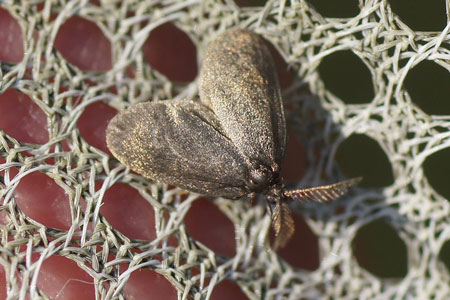 .. ..
 . .
 Psyche casta. Family bagworm moths, bagworms, bagmoths (Psychidae).
Psyche casta. Family bagworm moths, bagworms, bagmoths (Psychidae).
Males have hairy brown shiny wings. The females are wingless and about 4-5 mm long. She stays in the cocoon.
Wingspan: 12-15 mm.
Host plants for the caterpillar are plants like grasses, birch, willow, poplar. The caterpillar is protected by a case of pieces of grass.
May-July Two generations. The caterpillars overwinter.
Europe.Foto's 26-6-2014. German: Kleine Rauch-Sackträge.
 bag, case 15-5-2014.
bag, case 15-5-2014. |
Plume
moths (Pterophoridae).
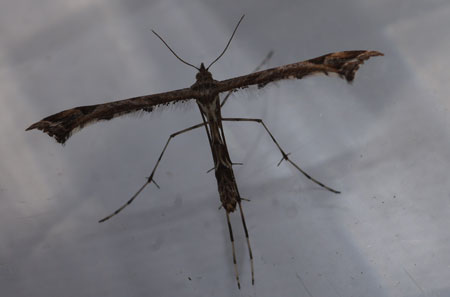 .. ..
 Amblyptilia acanthadactyla. Family Plume moths (Pterophoridae).
Amblyptilia acanthadactyla. Family Plume moths (Pterophoridae).
I found this moth in the pantry. It flies mostly during dusk. Previously, it was found only in the south of the Netherlands. Now it is a common moth. The moth overwinters.
The caterpillar ives is low plants. Including on currency, on different types of geraniums and heather.
The Amblyptilia acanthadactyla can be seen all year. (Between April and August overlapping generations)
Wingspan: 17-23 mm. Photo 15-6-2011. |
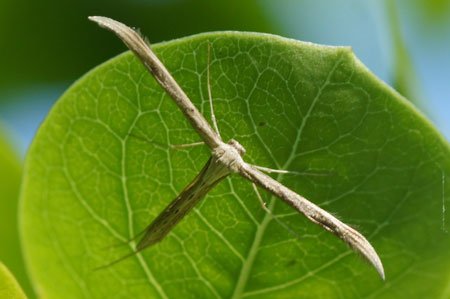 T-Moth or Morning-glory Plume Moth (Emmelina monodactyla). Family Plume moths
(Pterophoridae).
T-Moth or Morning-glory Plume Moth (Emmelina monodactyla). Family Plume moths
(Pterophoridae).
A very common moth. The plume moth is similar to other plume moths of the genus Stenoptilia. The colour is variable. From rusty brown to gray-white.
They fly at dusk and at night.
They fly almost the whole year. Especially in August, September. The moth
overwinters.
Wingspan: 18-27 mm.
Host plants for the caterpillars are particularly plants from the bindweed family, but they are also found on other plants.
Europe, Asia, North Africa, North America, Mexico. Photo 23-7-2012. French: Le Ptérophore commun. |
Clearwing moths
(Sesiidae).
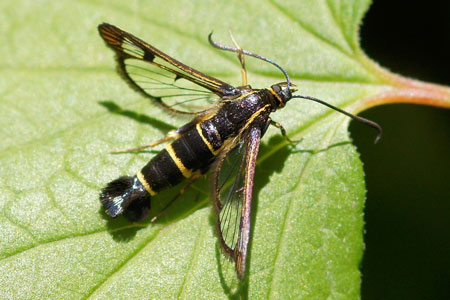 .. ..
 Currant Clearwing (Synanthedon tipuliformis) Family clearwing moths (Sesiidae) It is a day-active moth.
Currant Clearwing (Synanthedon tipuliformis) Family clearwing moths (Sesiidae) It is a day-active moth.
Like the broad-bordered bee hawk-moth it has transparent wings. It has a yellow collar. The young butterflies have two yellow lines on the thorax. The black abdomen of the males has three yellow bands. The females have two yellow bands.
Wingspan 17-20 mm.
Host plants of the genus Ribes and Spindle Tree. Caterpillars eat the bark and the wood. They hibernate in the branch.
Flight time: May to July. One generation.
Palearctic. Now also in North America, Asia and Australia. Photo 1-6-2011. German: Johannisbeerglasflügler. |
Hawk moths, sphinx moths, hornworms (Sphingidae).
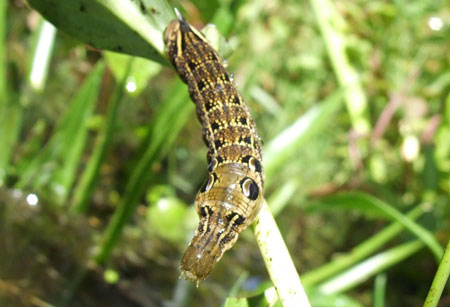 .. ..
 Elephant Hawk-moth (Deilephila elpenor) caterpillar. Subfamily Macroglossinae. Family Sphingidae.
Elephant Hawk-moth (Deilephila elpenor) caterpillar. Subfamily Macroglossinae. Family Sphingidae.
Unfortunately I have no picture of these beautiful moths.
When the 8 cm long brown caterpillar feels threatened it draws this snout in, towards its body and moves it slightly like on the photo. This posture resembles more a snake than an Elephant. It has also four large 'eye' markings at the head end.
It lives mainly on the fireweed. In the garden also on the fuchsia. Although there are fireweed and fuchsia's in the garden, it is here on Menyanthes.
It hibernates as a pupa.
The butterfly you'll find from May to June. 1 sometimes 2 generations. Wingspan 45-60 mm. German: Mittlere Weinschwärmer. French: Grand sphinx de la
vigne. More
photos
|
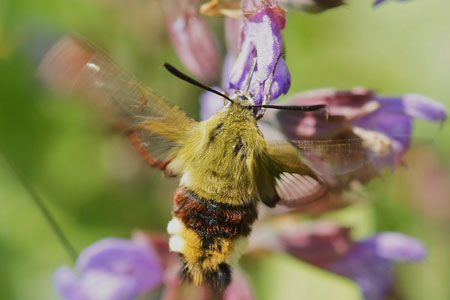 .. ..
 . .
 Broad-bordered Bee Hawk-moth (Hemaris
fuciformis). Subfamily Macroglossinae. Family Sphingidae. A day active moth.
Broad-bordered Bee Hawk-moth (Hemaris
fuciformis). Subfamily Macroglossinae. Family Sphingidae. A day active moth.
An easily recognizable moth with a yellow-brown fur with a reddish brown band and white spots on the side. The wings are partly transparent with a red border.
Like a hummingbird it flies from flower to flower and is drinking with its tongue the nectar. Include labiates and butterfly bushes. As you can see on the pictures, it moves its wings rapidly. Wingspan: 38-45 mm.
Flight time: May-July. In the Netherlands it is found in the coastal and sandy areas.
Europe (except northern Scandinavia), North Africa and Central and East Asia.
Caterpillars feed on snowberry and honeysuckle and other plants. June-August. They overwinter as pupa among the withered leaves. German: Hummelschwärme. French: sphinx
fuciforme, Sphinx-Gazé ou Sphinx du chèvrefeuille. |
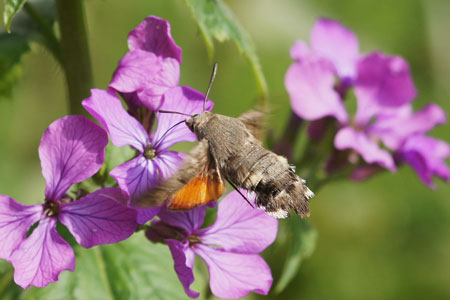 .. ..
 . .
 Hummingbird hawk-moth (Macroglossum
stellatarum). Subfamily Macroglossinae. Family Sphingidae. A day active moth.
Hummingbird hawk-moth (Macroglossum
stellatarum). Subfamily Macroglossinae. Family Sphingidae. A day active moth.
The forewings are grey-brown. The upper side of the hind wings is orange. The orange hind wings are visible, when it flies.
Like a hummingbird it flies from flower to flower and is drinking with its tongue the nectar. As you can see on the pictures, it moves its wings rapidly. Wingspan: 36-50 mm.
Flying time: April-October. Sometimes earlier like this hummingbird moth. It is both a migratory moth as a sedentary moth. They can fly in the summer to the north and fly in the winter to the south. Europe, North Africa and Asia.
The light green caterpillars are to be found in madder but also in other plants. Near those plants they pupate on the floor, between the leaves.
Photos 3-4-2014. German: Taubenschwänzchen, Taubenschwanz,
Karpfenschwanz. French: Moro sphinx, Sphinx colibri, Sphinx du caille-lait. |
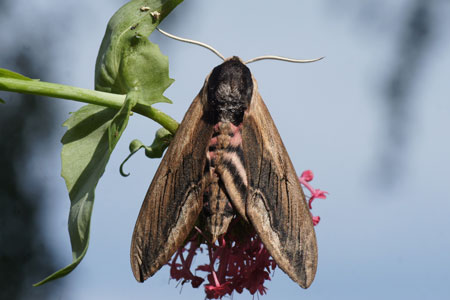 Privet hawk moth (Sphinx ligustri). Subfamily Sphinginae. Family Sphingidae.
Privet hawk moth (Sphinx ligustri). Subfamily Sphinginae. Family Sphingidae.
I found the caterpillars in holly in 2016. In June 2017 one was emerged into this moth.
A very large moth. The wings are brown with a dark brown strip. The body is pink with black bands.
Mid May-early September. The puppa overwinters.
The caterpillar feeds on privet, snowberry, elder, holly.......
Wingspan: 80-120 mm. Palearctic.


 . .
 . .
 Foto's
19-8-2016, 1-9-2016, 25-8-2016. 15-6-2017. Foto's
19-8-2016, 1-9-2016, 25-8-2016. 15-6-2017. |
Fungus moths, tineid moths
(Tineidae).
Many species can be harmful because the caterpillars
feed on dead organic material.
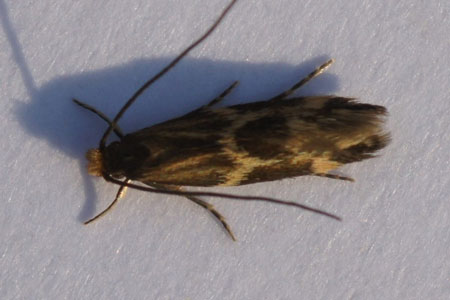 . .
 Yellow V moth (Oinophila v-flava). Subfamily Hieroxestinae. Family fungus moths, tineid moths (Tineidae). Non-native species. Rare in the Netherlands!
Yellow V moth (Oinophila v-flava). Subfamily Hieroxestinae. Family fungus moths, tineid moths (Tineidae). Non-native species. Rare in the Netherlands!
The forewings are brown, blackish brown with pale spots, which form a V-shaped pattern. Head with brown hair. Long antennae.
The moth is associated with wine cellars, because the caterpillars live on the fungus Zasmidium cellare and on wine corks. In nature, the caterpillar often lives in palm-like plants with stems. Sometimes they are found in the Netherlands. Mostly in urban areas
Wingspan: About 10 mm.
In North- and South America, Africa to South Africa and Mediterranean Europe, elsewhere it is a non-native species. Photos 4-5-2016. |
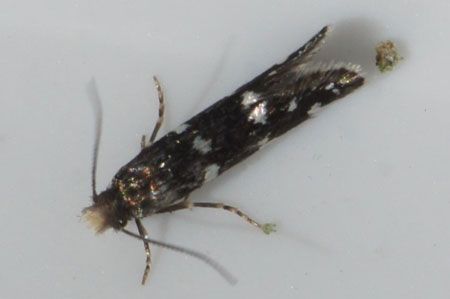 .. ..
 Silver-barred Clothes Moth (Infurcitinea argentimaculella). Subfamily Meessiinae. Family fungus moths, tineid moths
(Tineidae).
Silver-barred Clothes Moth (Infurcitinea argentimaculella). Subfamily Meessiinae. Family fungus moths, tineid moths
(Tineidae).
A dark moth with white spots. The caterpillars feed on lichens on stones and old trees and make
Wingspan 7-8 mm. July-August. Photos: 31-7-2017. |
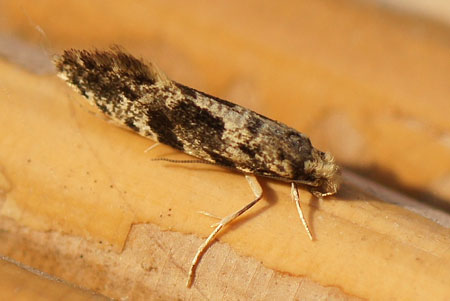 .. ..
 European Grain Moth (Nemapogon granella). Subfamily Nemapogoninae. Family fungus moths, tineid moths
(Tineidae).
European Grain Moth (Nemapogon granella). Subfamily Nemapogoninae. Family fungus moths, tineid moths
(Tineidae).
The forewings are irregularly mottled dark brown, white and grey. The grey-brown hind wings are surrounded by a fringe of long hair. On the head a tuft of yellowish-white hairs. It looks like the Nemapogon cloacella. The white spot in the center 3/4 of the wing is characteristic: present at N. cloacella and absent at N. granella .
Almost the whole year. Wingspan: 10-15 mm.
Host plants for the caterpillar are mushrooms, decaying or dead wood, dried products such as mushrooms and berries, groan, flour etc.
Worldwide. Photos 26-9-2012. |
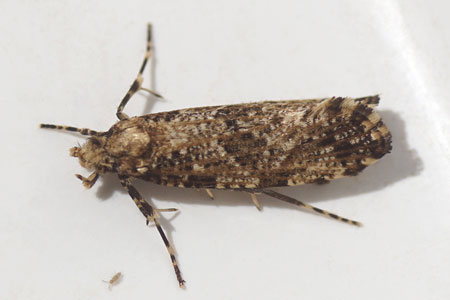 .. ..
 Morophaga choragella. Subfamily Scardiinae. Family fungus moths, tineid moths
(Tineidae).
Morophaga choragella. Subfamily Scardiinae. Family fungus moths, tineid moths
(Tineidae).
It looks like some other moths from the family, but it is larger.
The caterpillars live in different species of fungi.
Wingspan 20-30 mm. May-September. Photos 16-6-2018. |
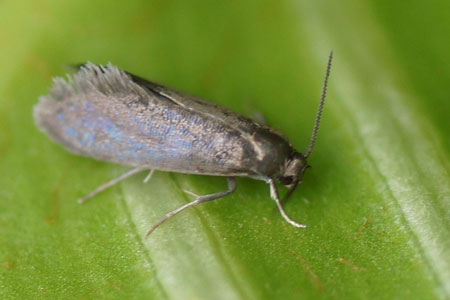 Psychoides verhuella. Subfamily Nemapogoninae. Family fungus moths, tineid moths (Tineidae).
Psychoides verhuella. Subfamily Nemapogoninae. Family fungus moths, tineid moths (Tineidae).
For the first time !!! found in the Netherlands, thanks Tymo Muus, who recognized it when he saw a picture of me.
The larva makes mines in ferns, especially in hartstongue fern, but also maidenhair spleenwort. The blotches are close to the midrib. After wintering they make a sort of cocoon where spores are attached to. Therefore it isn't easy to be found, but if you look closely, you'll see that the spores run in a different direction. See the photo of the mine.
A small gray moth, which gives a violet reflection in the sunlight.
Wingspan 9-12 mm. May-June.


 . .
 . .
 . .
 Photos 14, 15, 19, 21-6-2014. Caterpillar: 22-3-2015.
Photos 14, 15, 19, 21-6-2014. Caterpillar: 22-3-2015. |
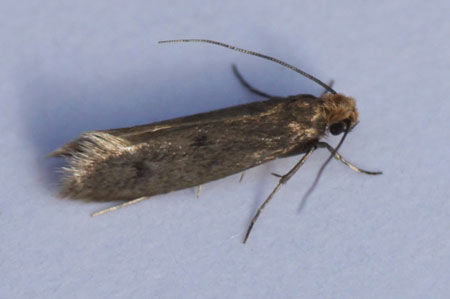 Case-bearing clothes moth (Tinea pellionella). Subfamily Tineinae. Family fungus moths, tineid moths
(Tineidae).
Case-bearing clothes moth (Tinea pellionella). Subfamily Tineinae. Family fungus moths, tineid moths
(Tineidae).
A grey moth with two dark spots and a brown hairy head.
We weren't happy with this moth. Without that we had noticed. they had laid eggs under the couch. The caterpillars have hatched, they spin a cocoon of silk and the fibres of the food source, here our rug. They are almost invisible in the rug. The damage to the rug, you can see in the photo.
The caterpillars feed on wool, fur, leather, feathers and hair.
Wingspan 9-16 mm. June-October. In houses also in other months.


 Photo moth: 23-6-2016. Caterpillar: 23-4-2016. Rug: 7-3-2016.
Photo moth: 23-6-2016. Caterpillar: 23-4-2016. Rug: 7-3-2016. |
Ermine moths (Yponomeutidae).
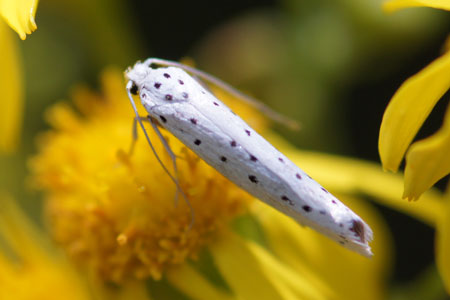 Ermine moth (Yponomeuta). Family Ermine moths (Yponomeutidae).
Ermine moth (Yponomeuta). Family Ermine moths (Yponomeutidae).
Perhaps Spindle Ermine (Yponomeuta cagnagella) But that isn't certain, because there are more dotted moths, which resemble and so far I haven't seen caterpillars in the spindle tree. The Orchard Ermine (Yponomeuta padella), and the Apple Ermine (Yponomeuta malinellus) are very similar. All the caterpillars have it their own food plants.
It's a day-flying moth.
Wingspan: 19-26 mm.
Flying time: June-October. Fortunately only one generation.
They overwinter as young caterpillars in the food plant. The caterpillars feed within a communal web. This web can completely cover a tree or bush. The webs protect the caterpillars from predators. They can strip the plant completely. When they pupate, the tree or bush will recover. The caterpillars haven't poisonous setae (hairs) like the Processionary (Thaumetopoea processionea). Photo 9-8-2010. On ragwort. |
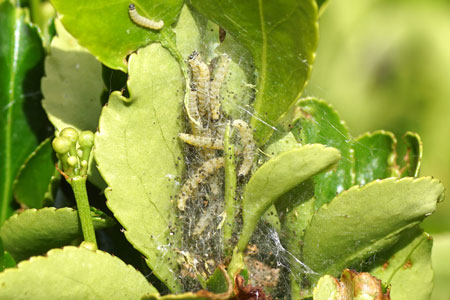 Ermine moth
(Yponomeuta). Family Ermine moths (Yponomeutidae). Ermine moth
(Yponomeuta). Family Ermine moths (Yponomeutidae).
Caterpillars in a communal web on the shrub Euonymus japonicus. Perhaps the spindle ermine (Yponomeuta cagnagella). But you can also find the caterpillars of Yponomeuta plumbella and Yponomeuta irrorella on Euonymus. So again I'm not sure. Photo 26-5-2023. |
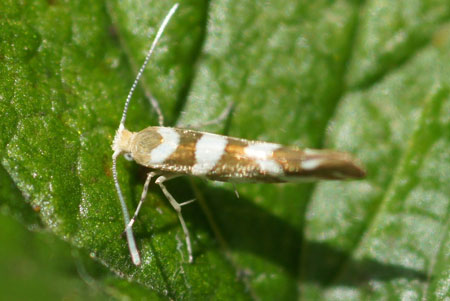 Argyresthia goedartella Genus Argyresthia. Family Ermine moths (Yponomeutidae).
Argyresthia goedartella Genus Argyresthia. Family Ermine moths (Yponomeutidae).
A golden night butterfly with white bands.
They fly both at night and afternoons.
Wingspan: 10-13 mm.
Flying time: May to October.
Host plants: birch, alder. Larva mines young shoots and catkins of these trees. There it overwinters. After the winter it leaves that place and pupates in a cocoon under the bark.
Europe, North America. Photo 23-7-2011. |
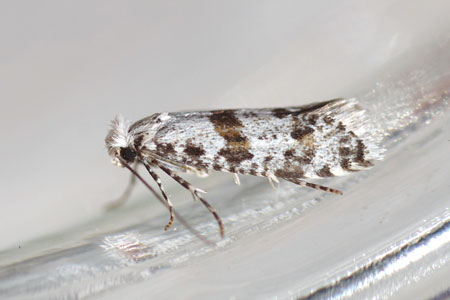 Hawthorn moth (Scythropia crataegella). Genus Argyresthia. Family Ermine moths (Yponomeutidae).
Hawthorn moth (Scythropia crataegella). Genus Argyresthia. Family Ermine moths (Yponomeutidae).
The moth is white with a dark pattern.
Wingspan: 11-15 millimeters.
Flight time: May - September. Two generations in a year.
Host plants: Plants from the rose family (Rosaceae) such as hawthorn, cotoneaster, apple.
Young caterpillars make mines in the leaves. Then they live together in a spinning under the leaf.
Europe. Photo 18-8-2018. |
Ypsolophidae.
 .. ..
 Ypsolopha alpella. Family Ypsolophidae.
Ypsolopha alpella. Family Ypsolophidae.
Golden yellow to tan with two brown bands over the forewings. It looks like the Ypsolopha sylvella, but this moth is browner with wider bands.
Wingspan: 14-18 mm.
Flight time: June-September. The caterpillar lives in May, June in a slight web on the underside of leaves of the oak. Photos 22-8-2018. |
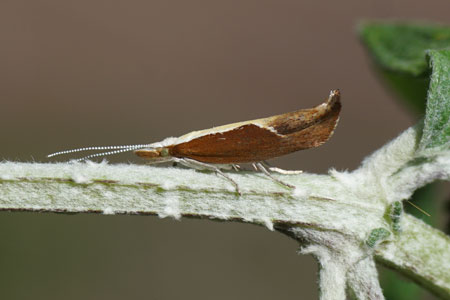 .. ..
 Honeysuckle moth( Ypsolopha dentella). Family Ypsolophidae.
Honeysuckle moth( Ypsolopha dentella). Family Ypsolophidae.
Maroon with a white top. A yellow-white wavy spot along the lower edge of the forewing.
Wingspan: 18-23 millimeters.
Flight time: late June-late September. The caterpillar lives in May, June in a
slight web between the leaves of the honeysuckle. Photos 2-7-2020. |
Burnet
moths, Forester moths, Smoky
moths (Zygaenidae).
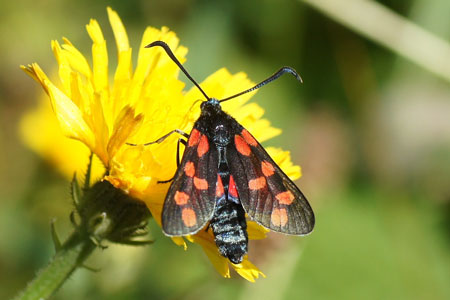 .. ..
 Six-spot Burnet (Zygaena filipendulae). Family Burnet moths, Forester moths (Zygaenidae).
Not in the garden but in the dunes 4 km from our house.
Six-spot Burnet (Zygaena filipendulae). Family Burnet moths, Forester moths (Zygaenidae).
Not in the garden but in the dunes 4 km from our house.
A diurnal moth. The red spots on the black forewings resemble drops of blood. The hind wings are red.
It is sometimes mistaken for the cinnabar moth (Tyria jacobaeae).
Wingspan: about 38 mm.
Host plants for the caterpillar are Bird's-foot Trefoil and Greater Bird's-foot Trefoil.
May-August. One generation. The caterpillars overwinter.
Europe. Photos 26-7-2012. German: Sechsfleck-Widderchen. French: Zygène de la spirée. |
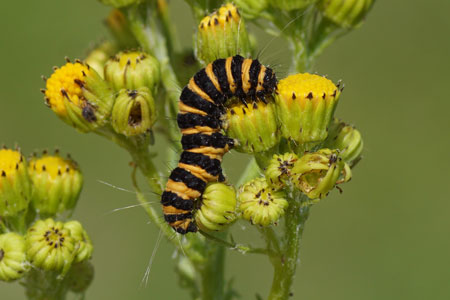 Caterpillar cinnabar moth (Tyria jacobaeae). Family Burnet moths, Forester moths
(Zygaenidae).
Not in the garden but in the dunes 4 km from our house.
Caterpillar cinnabar moth (Tyria jacobaeae). Family Burnet moths, Forester moths
(Zygaenidae).
Not in the garden but in the dunes 4 km from our house.
A diurnal moth. It's the first time I've seen the caterpillar so close to home. The orange-yellow black caterpillar feeds on the poisonous ragwort herb and other ragwort species. In this photo on
Jacobaea vulgaris subsp. dunensis,
Caterpillar: July-September. Butterfly: April-August. One generations. Quite long flight time because the pupae do not hatch at the same time. They overwinter as pupa in the ground.
Butterfly with black forewing with two red dots and a red stripe along the edge. The hindwing is red with black edges. Wingspan: about 32-45mm.
Europe, Western and Central Asia. Introduced to New Zealand, Australia and North America to control ragwort there. Photo 6-7-2022. |
Nederlands /
Dutch
 
Subpage France:
Insects
France
Subpage butterflies and moths: Butterflies
Owlet
moths, noctuidae Geometer
moths Leafrollers,
tortrix moths Pyralidae,
Crambidae Concealer
moths, Oecophoridae
|
